Financial Analysis of Etisalat: Ratios, Trends, and Insights Report
VerifiedAdded on 2021/04/23
|10
|1782
|165
Report
AI Summary
This report presents a financial analysis of Etisalat, evaluating its performance from 2015 to 2017. It examines profitability through net profit margin and ROA, comparing Etisalat to its competitor Du and industry standards. Liquidity is assessed using current and cash ratios, highlighting Etisalat's ability to meet short-term obligations. Solvency is analyzed via debt-to-asset and debt-to-equity ratios, revealing Etisalat's leverage and asset financing strategies. Efficiency is evaluated using asset turnover and inventory turnover ratios, comparing Etisalat's operational efficiency to competitors and industry benchmarks. Coverage and market prospect ratios, including interest coverage and P/E ratios, are also analyzed, offering insights into Etisalat's financial risk and investor appeal. The analysis provides a comprehensive overview of Etisalat's financial health, identifying trends and comparing its performance to industry standards.

RUNNING HEAD: Financial Analysis of Etisalat Page 1 of 10
Financial Analysis of Etisalat
Student Name
Date
Financial Analysis of Etisalat
Student Name
Date
Paraphrase This Document
Need a fresh take? Get an instant paraphrase of this document with our AI Paraphraser
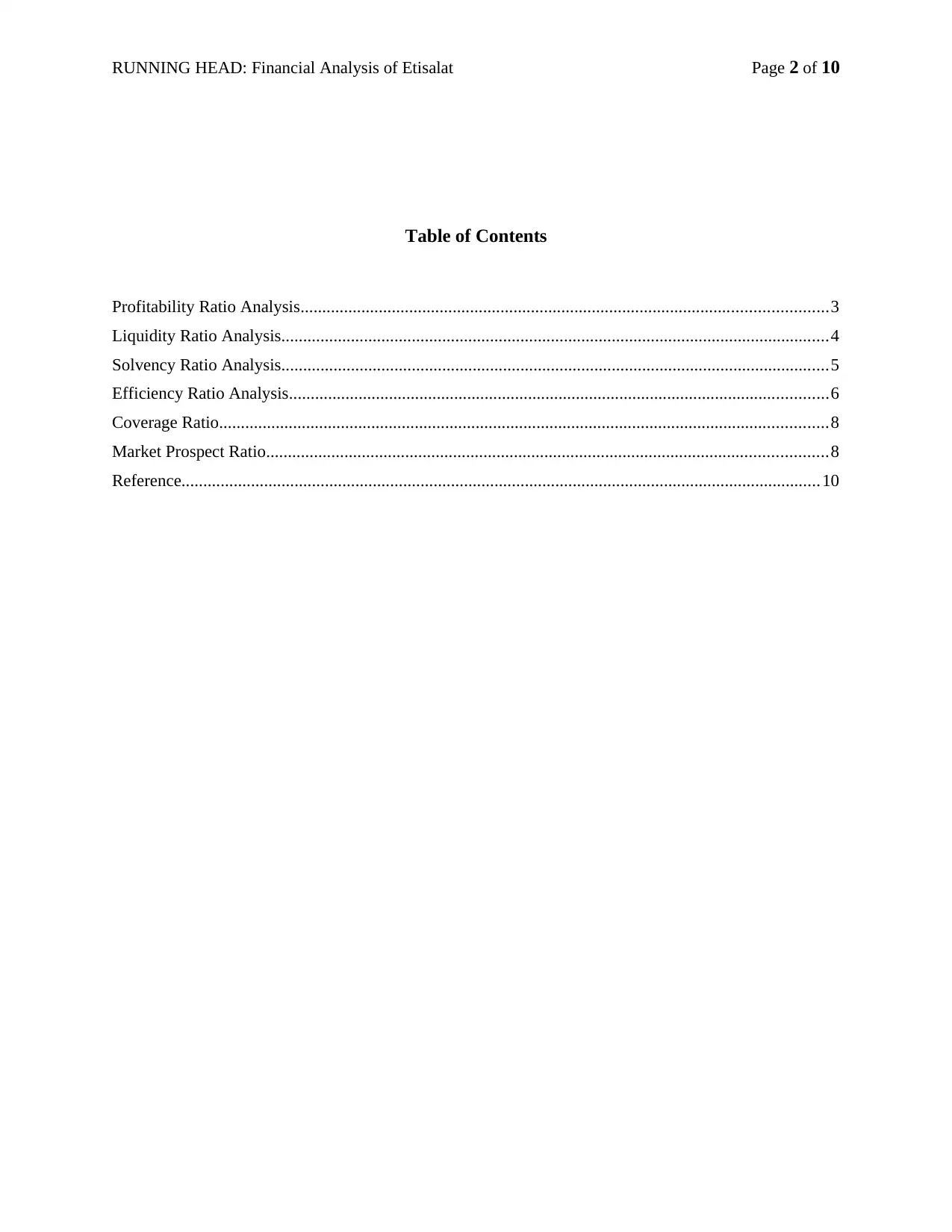
RUNNING HEAD: Financial Analysis of Etisalat Page 2 of 10
Table of Contents
Profitability Ratio Analysis.........................................................................................................................3
Liquidity Ratio Analysis..............................................................................................................................4
Solvency Ratio Analysis..............................................................................................................................5
Efficiency Ratio Analysis............................................................................................................................6
Coverage Ratio............................................................................................................................................8
Market Prospect Ratio.................................................................................................................................8
Reference...................................................................................................................................................10
Table of Contents
Profitability Ratio Analysis.........................................................................................................................3
Liquidity Ratio Analysis..............................................................................................................................4
Solvency Ratio Analysis..............................................................................................................................5
Efficiency Ratio Analysis............................................................................................................................6
Coverage Ratio............................................................................................................................................8
Market Prospect Ratio.................................................................................................................................8
Reference...................................................................................................................................................10
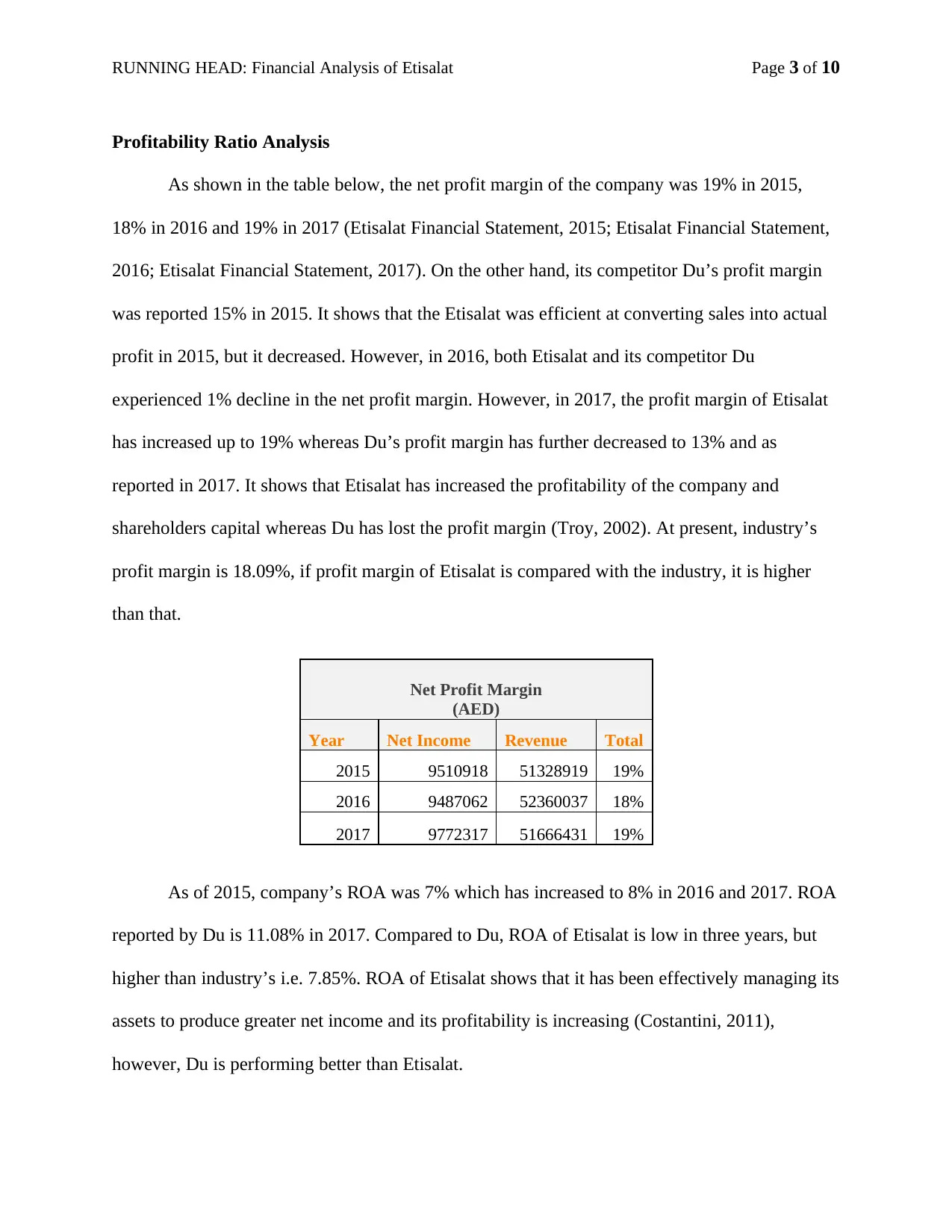
RUNNING HEAD: Financial Analysis of Etisalat Page 3 of 10
Profitability Ratio Analysis
As shown in the table below, the net profit margin of the company was 19% in 2015,
18% in 2016 and 19% in 2017 (Etisalat Financial Statement, 2015; Etisalat Financial Statement,
2016; Etisalat Financial Statement, 2017). On the other hand, its competitor Du’s profit margin
was reported 15% in 2015. It shows that the Etisalat was efficient at converting sales into actual
profit in 2015, but it decreased. However, in 2016, both Etisalat and its competitor Du
experienced 1% decline in the net profit margin. However, in 2017, the profit margin of Etisalat
has increased up to 19% whereas Du’s profit margin has further decreased to 13% and as
reported in 2017. It shows that Etisalat has increased the profitability of the company and
shareholders capital whereas Du has lost the profit margin (Troy, 2002). At present, industry’s
profit margin is 18.09%, if profit margin of Etisalat is compared with the industry, it is higher
than that.
Net Profit Margin
(AED)
Year Net Income Revenue Total
2015 9510918 51328919 19%
2016 9487062 52360037 18%
2017 9772317 51666431 19%
As of 2015, company’s ROA was 7% which has increased to 8% in 2016 and 2017. ROA
reported by Du is 11.08% in 2017. Compared to Du, ROA of Etisalat is low in three years, but
higher than industry’s i.e. 7.85%. ROA of Etisalat shows that it has been effectively managing its
assets to produce greater net income and its profitability is increasing (Costantini, 2011),
however, Du is performing better than Etisalat.
Profitability Ratio Analysis
As shown in the table below, the net profit margin of the company was 19% in 2015,
18% in 2016 and 19% in 2017 (Etisalat Financial Statement, 2015; Etisalat Financial Statement,
2016; Etisalat Financial Statement, 2017). On the other hand, its competitor Du’s profit margin
was reported 15% in 2015. It shows that the Etisalat was efficient at converting sales into actual
profit in 2015, but it decreased. However, in 2016, both Etisalat and its competitor Du
experienced 1% decline in the net profit margin. However, in 2017, the profit margin of Etisalat
has increased up to 19% whereas Du’s profit margin has further decreased to 13% and as
reported in 2017. It shows that Etisalat has increased the profitability of the company and
shareholders capital whereas Du has lost the profit margin (Troy, 2002). At present, industry’s
profit margin is 18.09%, if profit margin of Etisalat is compared with the industry, it is higher
than that.
Net Profit Margin
(AED)
Year Net Income Revenue Total
2015 9510918 51328919 19%
2016 9487062 52360037 18%
2017 9772317 51666431 19%
As of 2015, company’s ROA was 7% which has increased to 8% in 2016 and 2017. ROA
reported by Du is 11.08% in 2017. Compared to Du, ROA of Etisalat is low in three years, but
higher than industry’s i.e. 7.85%. ROA of Etisalat shows that it has been effectively managing its
assets to produce greater net income and its profitability is increasing (Costantini, 2011),
however, Du is performing better than Etisalat.
⊘ This is a preview!⊘
Do you want full access?
Subscribe today to unlock all pages.

Trusted by 1+ million students worldwide
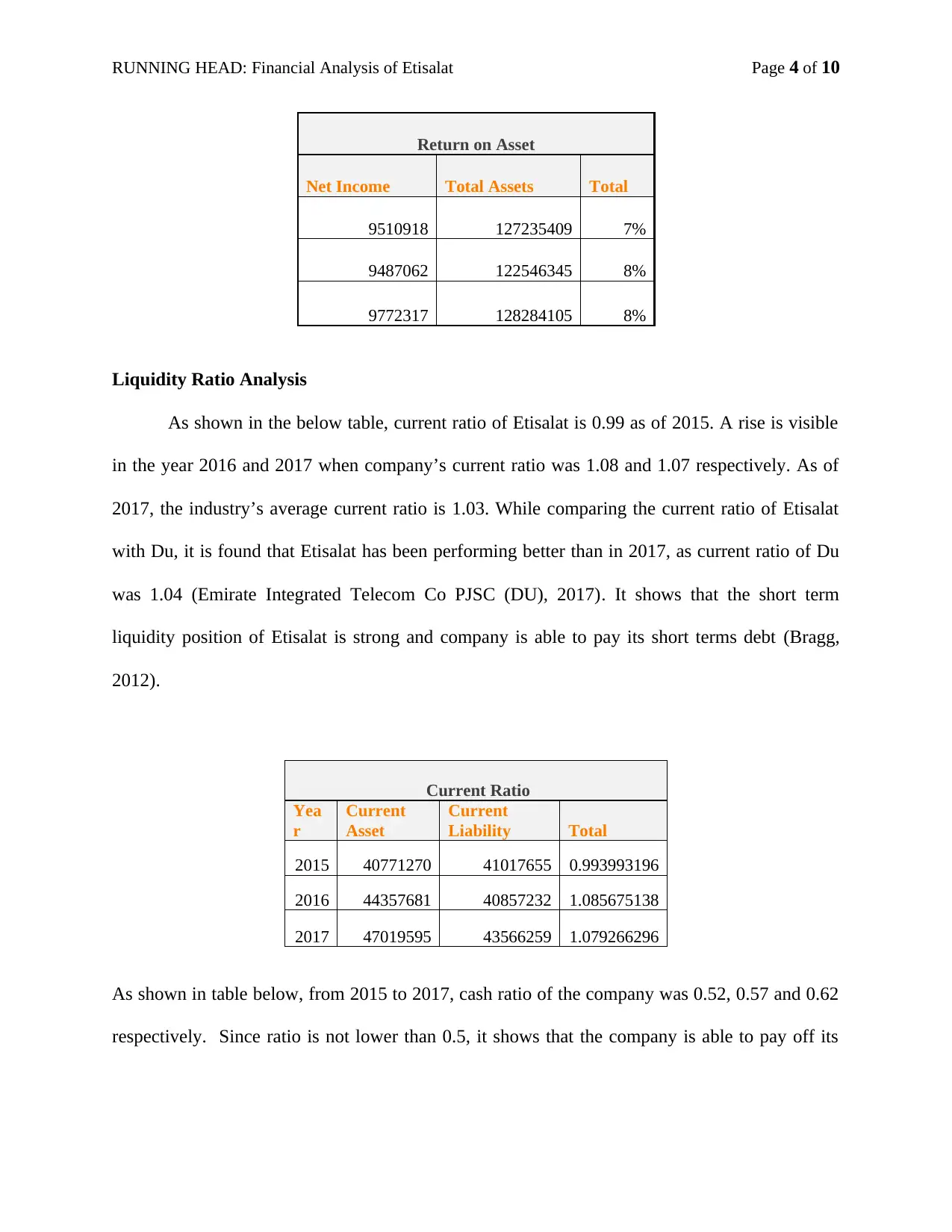
RUNNING HEAD: Financial Analysis of Etisalat Page 4 of 10
Return on Asset
Net Income Total Assets Total
9510918 127235409 7%
9487062 122546345 8%
9772317 128284105 8%
Liquidity Ratio Analysis
As shown in the below table, current ratio of Etisalat is 0.99 as of 2015. A rise is visible
in the year 2016 and 2017 when company’s current ratio was 1.08 and 1.07 respectively. As of
2017, the industry’s average current ratio is 1.03. While comparing the current ratio of Etisalat
with Du, it is found that Etisalat has been performing better than in 2017, as current ratio of Du
was 1.04 (Emirate Integrated Telecom Co PJSC (DU), 2017). It shows that the short term
liquidity position of Etisalat is strong and company is able to pay its short terms debt (Bragg,
2012).
Current Ratio
Yea
r
Current
Asset
Current
Liability Total
2015 40771270 41017655 0.993993196
2016 44357681 40857232 1.085675138
2017 47019595 43566259 1.079266296
As shown in table below, from 2015 to 2017, cash ratio of the company was 0.52, 0.57 and 0.62
respectively. Since ratio is not lower than 0.5, it shows that the company is able to pay off its
Return on Asset
Net Income Total Assets Total
9510918 127235409 7%
9487062 122546345 8%
9772317 128284105 8%
Liquidity Ratio Analysis
As shown in the below table, current ratio of Etisalat is 0.99 as of 2015. A rise is visible
in the year 2016 and 2017 when company’s current ratio was 1.08 and 1.07 respectively. As of
2017, the industry’s average current ratio is 1.03. While comparing the current ratio of Etisalat
with Du, it is found that Etisalat has been performing better than in 2017, as current ratio of Du
was 1.04 (Emirate Integrated Telecom Co PJSC (DU), 2017). It shows that the short term
liquidity position of Etisalat is strong and company is able to pay its short terms debt (Bragg,
2012).
Current Ratio
Yea
r
Current
Asset
Current
Liability Total
2015 40771270 41017655 0.993993196
2016 44357681 40857232 1.085675138
2017 47019595 43566259 1.079266296
As shown in table below, from 2015 to 2017, cash ratio of the company was 0.52, 0.57 and 0.62
respectively. Since ratio is not lower than 0.5, it shows that the company is able to pay off its
Paraphrase This Document
Need a fresh take? Get an instant paraphrase of this document with our AI Paraphraser
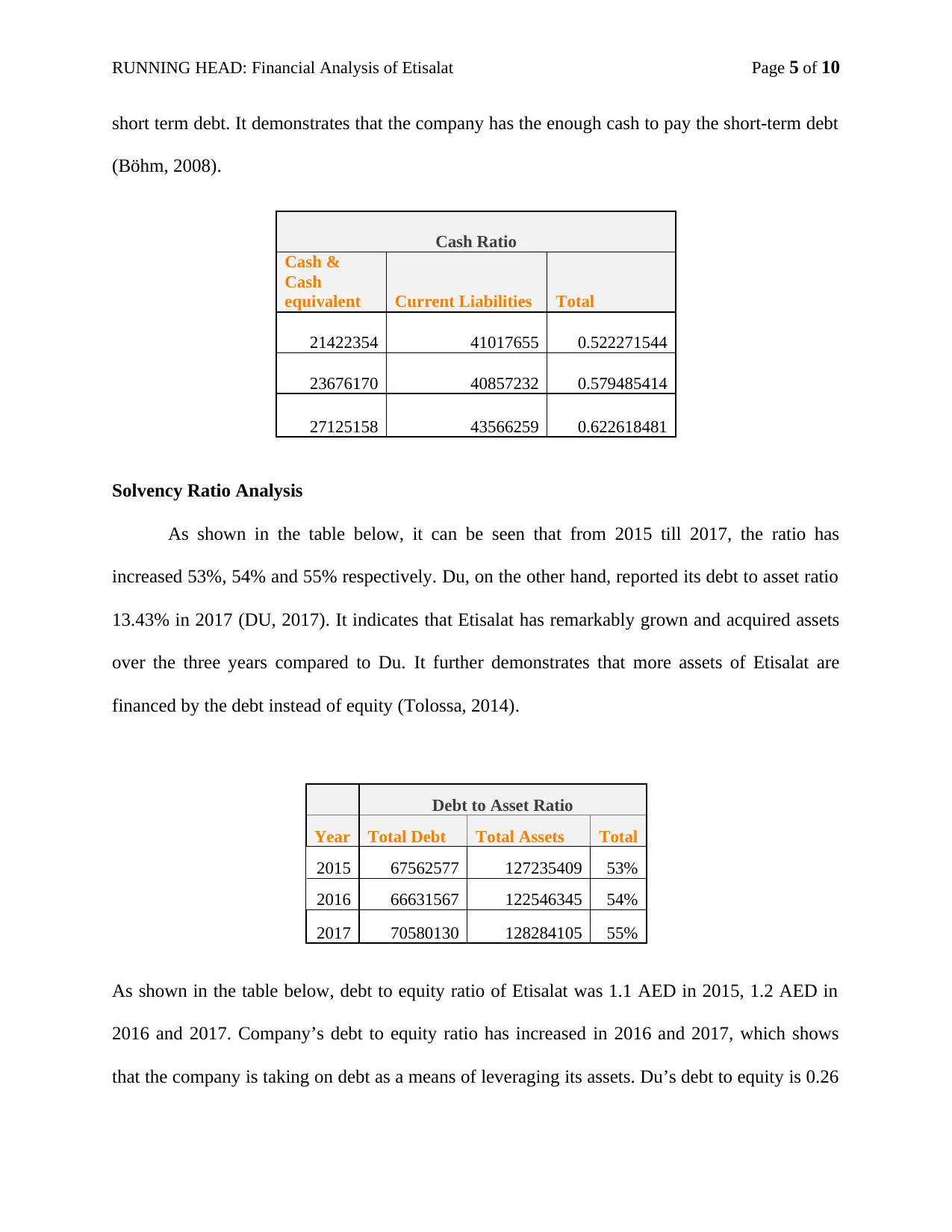
RUNNING HEAD: Financial Analysis of Etisalat Page 5 of 10
short term debt. It demonstrates that the company has the enough cash to pay the short-term debt
(Böhm, 2008).
Cash Ratio
Cash &
Cash
equivalent Current Liabilities Total
21422354 41017655 0.522271544
23676170 40857232 0.579485414
27125158 43566259 0.622618481
Solvency Ratio Analysis
As shown in the table below, it can be seen that from 2015 till 2017, the ratio has
increased 53%, 54% and 55% respectively. Du, on the other hand, reported its debt to asset ratio
13.43% in 2017 (DU, 2017). It indicates that Etisalat has remarkably grown and acquired assets
over the three years compared to Du. It further demonstrates that more assets of Etisalat are
financed by the debt instead of equity (Tolossa, 2014).
Debt to Asset Ratio
Year Total Debt Total Assets Total
2015 67562577 127235409 53%
2016 66631567 122546345 54%
2017 70580130 128284105 55%
As shown in the table below, debt to equity ratio of Etisalat was 1.1 AED in 2015, 1.2 AED in
2016 and 2017. Company’s debt to equity ratio has increased in 2016 and 2017, which shows
that the company is taking on debt as a means of leveraging its assets. Du’s debt to equity is 0.26
short term debt. It demonstrates that the company has the enough cash to pay the short-term debt
(Böhm, 2008).
Cash Ratio
Cash &
Cash
equivalent Current Liabilities Total
21422354 41017655 0.522271544
23676170 40857232 0.579485414
27125158 43566259 0.622618481
Solvency Ratio Analysis
As shown in the table below, it can be seen that from 2015 till 2017, the ratio has
increased 53%, 54% and 55% respectively. Du, on the other hand, reported its debt to asset ratio
13.43% in 2017 (DU, 2017). It indicates that Etisalat has remarkably grown and acquired assets
over the three years compared to Du. It further demonstrates that more assets of Etisalat are
financed by the debt instead of equity (Tolossa, 2014).
Debt to Asset Ratio
Year Total Debt Total Assets Total
2015 67562577 127235409 53%
2016 66631567 122546345 54%
2017 70580130 128284105 55%
As shown in the table below, debt to equity ratio of Etisalat was 1.1 AED in 2015, 1.2 AED in
2016 and 2017. Company’s debt to equity ratio has increased in 2016 and 2017, which shows
that the company is taking on debt as a means of leveraging its assets. Du’s debt to equity is 0.26

RUNNING HEAD: Financial Analysis of Etisalat Page 6 of 10
AED whereas industry standard is 0.54 AED (DU, 2017). When compare it with Du’s and
industry’s debt to equity, Etisalat’s ratio shows that it is aggressive in financing the growth with
debt, which increases the high risk for the company (Bragg, 2012).
Debt to Equity Ratio
Total Debt Total Equity Total
67562577 59672832 1.1
66631567 55914778 1.2
70580130 57703975 1.2
Efficiency Ratio Analysis
As shown in the table below, asset turnover ratio of Etisalat is 0.40 AED in 2015, which
has increased to 0.41 AED in 2016 and 2017. Du’s ratio as of 2017 was 0.82 AED, which is
higher than Etisalat. Higher asset turnover ratio is better because it shows the Du’s is generating
more sales from its assets compared to Etisalat. However, it is also important to notify here that
in 2017, industry’s standard was 0.44 AED (Emirate Integrated Telecom Co PJSC (DU), 2017).
Therefore, although, Etisalat is generating less sales against its asset compared to Du but as per
the industry’s standard, its performance is good (Tolossa, 2014).
AED whereas industry standard is 0.54 AED (DU, 2017). When compare it with Du’s and
industry’s debt to equity, Etisalat’s ratio shows that it is aggressive in financing the growth with
debt, which increases the high risk for the company (Bragg, 2012).
Debt to Equity Ratio
Total Debt Total Equity Total
67562577 59672832 1.1
66631567 55914778 1.2
70580130 57703975 1.2
Efficiency Ratio Analysis
As shown in the table below, asset turnover ratio of Etisalat is 0.40 AED in 2015, which
has increased to 0.41 AED in 2016 and 2017. Du’s ratio as of 2017 was 0.82 AED, which is
higher than Etisalat. Higher asset turnover ratio is better because it shows the Du’s is generating
more sales from its assets compared to Etisalat. However, it is also important to notify here that
in 2017, industry’s standard was 0.44 AED (Emirate Integrated Telecom Co PJSC (DU), 2017).
Therefore, although, Etisalat is generating less sales against its asset compared to Du but as per
the industry’s standard, its performance is good (Tolossa, 2014).
⊘ This is a preview!⊘
Do you want full access?
Subscribe today to unlock all pages.

Trusted by 1+ million students worldwide
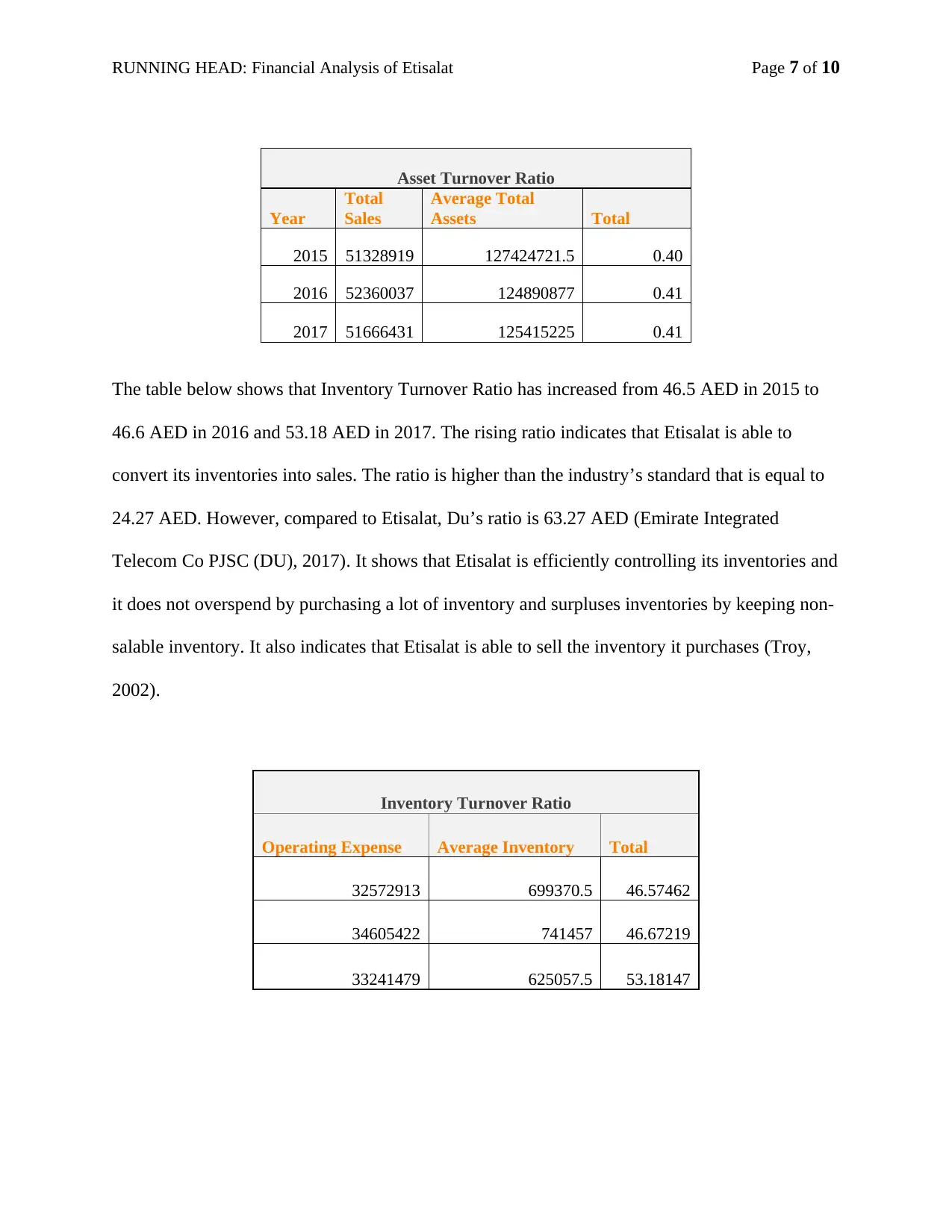
RUNNING HEAD: Financial Analysis of Etisalat Page 7 of 10
Asset Turnover Ratio
Year
Total
Sales
Average Total
Assets Total
2015 51328919 127424721.5 0.40
2016 52360037 124890877 0.41
2017 51666431 125415225 0.41
The table below shows that Inventory Turnover Ratio has increased from 46.5 AED in 2015 to
46.6 AED in 2016 and 53.18 AED in 2017. The rising ratio indicates that Etisalat is able to
convert its inventories into sales. The ratio is higher than the industry’s standard that is equal to
24.27 AED. However, compared to Etisalat, Du’s ratio is 63.27 AED (Emirate Integrated
Telecom Co PJSC (DU), 2017). It shows that Etisalat is efficiently controlling its inventories and
it does not overspend by purchasing a lot of inventory and surpluses inventories by keeping non-
salable inventory. It also indicates that Etisalat is able to sell the inventory it purchases (Troy,
2002).
Inventory Turnover Ratio
Operating Expense Average Inventory Total
32572913 699370.5 46.57462
34605422 741457 46.67219
33241479 625057.5 53.18147
Asset Turnover Ratio
Year
Total
Sales
Average Total
Assets Total
2015 51328919 127424721.5 0.40
2016 52360037 124890877 0.41
2017 51666431 125415225 0.41
The table below shows that Inventory Turnover Ratio has increased from 46.5 AED in 2015 to
46.6 AED in 2016 and 53.18 AED in 2017. The rising ratio indicates that Etisalat is able to
convert its inventories into sales. The ratio is higher than the industry’s standard that is equal to
24.27 AED. However, compared to Etisalat, Du’s ratio is 63.27 AED (Emirate Integrated
Telecom Co PJSC (DU), 2017). It shows that Etisalat is efficiently controlling its inventories and
it does not overspend by purchasing a lot of inventory and surpluses inventories by keeping non-
salable inventory. It also indicates that Etisalat is able to sell the inventory it purchases (Troy,
2002).
Inventory Turnover Ratio
Operating Expense Average Inventory Total
32572913 699370.5 46.57462
34605422 741457 46.67219
33241479 625057.5 53.18147
Paraphrase This Document
Need a fresh take? Get an instant paraphrase of this document with our AI Paraphraser
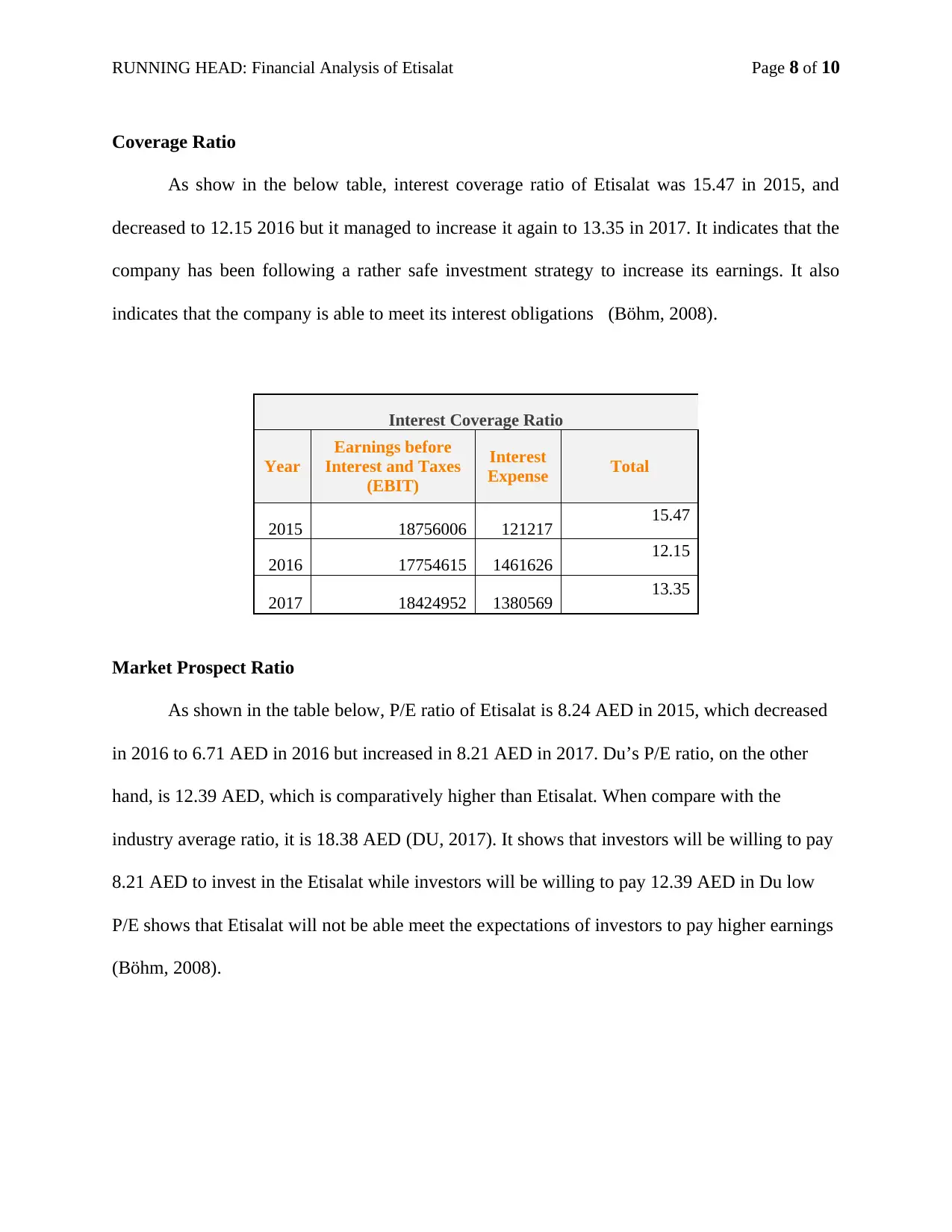
RUNNING HEAD: Financial Analysis of Etisalat Page 8 of 10
Coverage Ratio
As show in the below table, interest coverage ratio of Etisalat was 15.47 in 2015, and
decreased to 12.15 2016 but it managed to increase it again to 13.35 in 2017. It indicates that the
company has been following a rather safe investment strategy to increase its earnings. It also
indicates that the company is able to meet its interest obligations (Böhm, 2008).
Interest Coverage Ratio
Year
Earnings before
Interest and Taxes
(EBIT)
Interest
Expense Total
2015 18756006 121217 15.47
2016 17754615 1461626 12.15
2017 18424952 1380569 13.35
Market Prospect Ratio
As shown in the table below, P/E ratio of Etisalat is 8.24 AED in 2015, which decreased
in 2016 to 6.71 AED in 2016 but increased in 8.21 AED in 2017. Du’s P/E ratio, on the other
hand, is 12.39 AED, which is comparatively higher than Etisalat. When compare with the
industry average ratio, it is 18.38 AED (DU, 2017). It shows that investors will be willing to pay
8.21 AED to invest in the Etisalat while investors will be willing to pay 12.39 AED in Du low
P/E shows that Etisalat will not be able meet the expectations of investors to pay higher earnings
(Böhm, 2008).
Coverage Ratio
As show in the below table, interest coverage ratio of Etisalat was 15.47 in 2015, and
decreased to 12.15 2016 but it managed to increase it again to 13.35 in 2017. It indicates that the
company has been following a rather safe investment strategy to increase its earnings. It also
indicates that the company is able to meet its interest obligations (Böhm, 2008).
Interest Coverage Ratio
Year
Earnings before
Interest and Taxes
(EBIT)
Interest
Expense Total
2015 18756006 121217 15.47
2016 17754615 1461626 12.15
2017 18424952 1380569 13.35
Market Prospect Ratio
As shown in the table below, P/E ratio of Etisalat is 8.24 AED in 2015, which decreased
in 2016 to 6.71 AED in 2016 but increased in 8.21 AED in 2017. Du’s P/E ratio, on the other
hand, is 12.39 AED, which is comparatively higher than Etisalat. When compare with the
industry average ratio, it is 18.38 AED (DU, 2017). It shows that investors will be willing to pay
8.21 AED to invest in the Etisalat while investors will be willing to pay 12.39 AED in Du low
P/E shows that Etisalat will not be able meet the expectations of investors to pay higher earnings
(Böhm, 2008).

RUNNING HEAD: Financial Analysis of Etisalat Page 9 of 10
Price/Earnings Ratio
Year Market value
price per share
Earnings per
share Total
2015 15.917 1.93 8.2
2016 13.364 1.99 6.71
2017 16.095 1.96 8.21
As shown in the table below, earning per share of Etisalat is 0.019 AED in 2015, and decreased
to 0.009 AED in 2016 but further increased to 0.017 AED in 2017. Du’s earning per share, on
the other hand, 0.40 and industry’s average is 0.89 (DU, 2017). It indicates that Etisalat is not
earning enough on each share for its shareholders against the value of the share (Bragg, 2012).
Earnings Per Share
Net Income Preferred Dividends
Weighted average
common Share
Outstanding
Total
9510918 8164013 71278322 0.019
9487062 8754090 78230000 0.009
9772317 8428988 77245130 0.017
Price/Earnings Ratio
Year Market value
price per share
Earnings per
share Total
2015 15.917 1.93 8.2
2016 13.364 1.99 6.71
2017 16.095 1.96 8.21
As shown in the table below, earning per share of Etisalat is 0.019 AED in 2015, and decreased
to 0.009 AED in 2016 but further increased to 0.017 AED in 2017. Du’s earning per share, on
the other hand, 0.40 and industry’s average is 0.89 (DU, 2017). It indicates that Etisalat is not
earning enough on each share for its shareholders against the value of the share (Bragg, 2012).
Earnings Per Share
Net Income Preferred Dividends
Weighted average
common Share
Outstanding
Total
9510918 8164013 71278322 0.019
9487062 8754090 78230000 0.009
9772317 8428988 77245130 0.017
⊘ This is a preview!⊘
Do you want full access?
Subscribe today to unlock all pages.

Trusted by 1+ million students worldwide
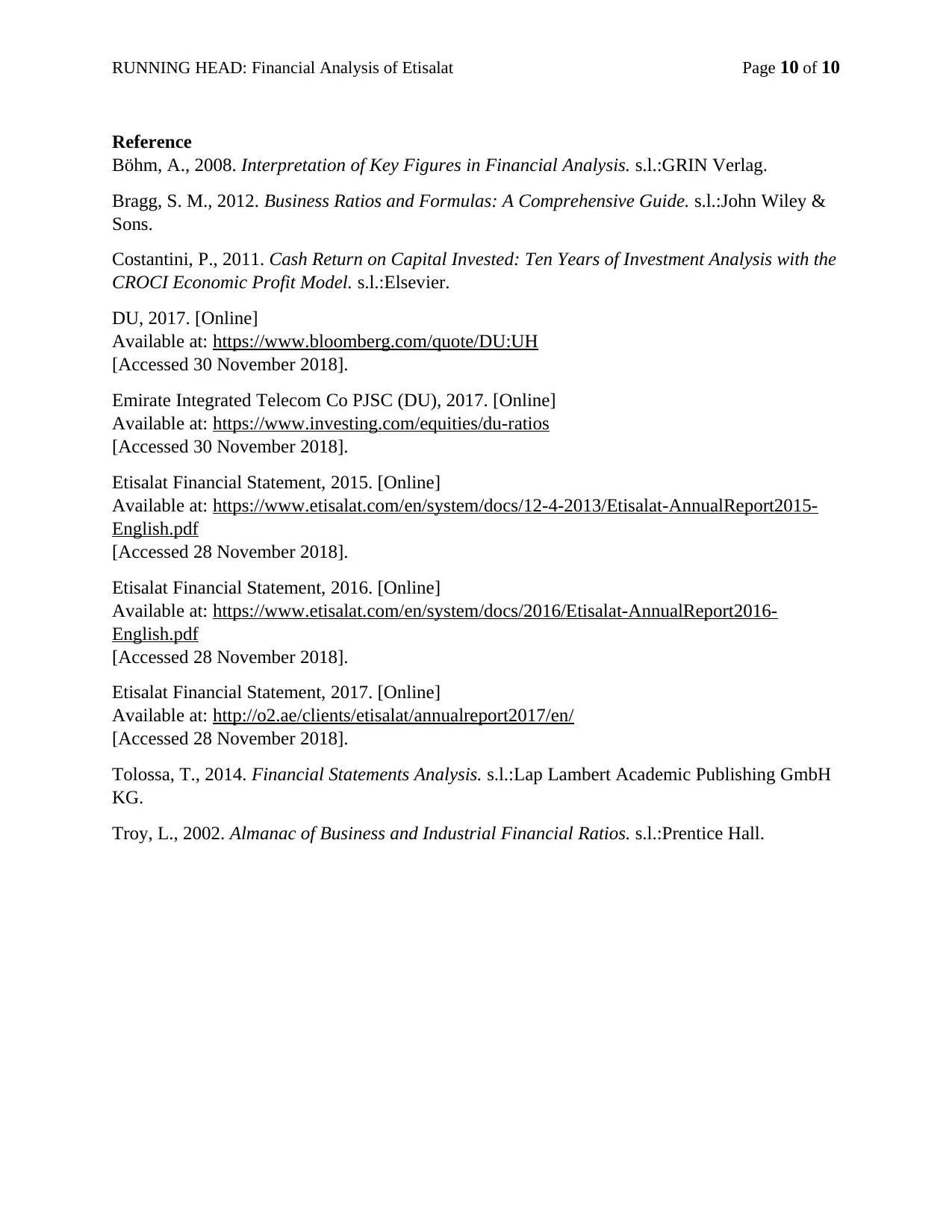
RUNNING HEAD: Financial Analysis of Etisalat Page 10 of 10
Reference
Böhm, A., 2008. Interpretation of Key Figures in Financial Analysis. s.l.:GRIN Verlag.
Bragg, S. M., 2012. Business Ratios and Formulas: A Comprehensive Guide. s.l.:John Wiley &
Sons.
Costantini, P., 2011. Cash Return on Capital Invested: Ten Years of Investment Analysis with the
CROCI Economic Profit Model. s.l.:Elsevier.
DU, 2017. [Online]
Available at: https://www.bloomberg.com/quote/DU:UH
[Accessed 30 November 2018].
Emirate Integrated Telecom Co PJSC (DU), 2017. [Online]
Available at: https://www.investing.com/equities/du-ratios
[Accessed 30 November 2018].
Etisalat Financial Statement, 2015. [Online]
Available at: https://www.etisalat.com/en/system/docs/12-4-2013/Etisalat-AnnualReport2015-
English.pdf
[Accessed 28 November 2018].
Etisalat Financial Statement, 2016. [Online]
Available at: https://www.etisalat.com/en/system/docs/2016/Etisalat-AnnualReport2016-
English.pdf
[Accessed 28 November 2018].
Etisalat Financial Statement, 2017. [Online]
Available at: http://o2.ae/clients/etisalat/annualreport2017/en/
[Accessed 28 November 2018].
Tolossa, T., 2014. Financial Statements Analysis. s.l.:Lap Lambert Academic Publishing GmbH
KG.
Troy, L., 2002. Almanac of Business and Industrial Financial Ratios. s.l.:Prentice Hall.
Reference
Böhm, A., 2008. Interpretation of Key Figures in Financial Analysis. s.l.:GRIN Verlag.
Bragg, S. M., 2012. Business Ratios and Formulas: A Comprehensive Guide. s.l.:John Wiley &
Sons.
Costantini, P., 2011. Cash Return on Capital Invested: Ten Years of Investment Analysis with the
CROCI Economic Profit Model. s.l.:Elsevier.
DU, 2017. [Online]
Available at: https://www.bloomberg.com/quote/DU:UH
[Accessed 30 November 2018].
Emirate Integrated Telecom Co PJSC (DU), 2017. [Online]
Available at: https://www.investing.com/equities/du-ratios
[Accessed 30 November 2018].
Etisalat Financial Statement, 2015. [Online]
Available at: https://www.etisalat.com/en/system/docs/12-4-2013/Etisalat-AnnualReport2015-
English.pdf
[Accessed 28 November 2018].
Etisalat Financial Statement, 2016. [Online]
Available at: https://www.etisalat.com/en/system/docs/2016/Etisalat-AnnualReport2016-
English.pdf
[Accessed 28 November 2018].
Etisalat Financial Statement, 2017. [Online]
Available at: http://o2.ae/clients/etisalat/annualreport2017/en/
[Accessed 28 November 2018].
Tolossa, T., 2014. Financial Statements Analysis. s.l.:Lap Lambert Academic Publishing GmbH
KG.
Troy, L., 2002. Almanac of Business and Industrial Financial Ratios. s.l.:Prentice Hall.
1 out of 10
Related Documents
Your All-in-One AI-Powered Toolkit for Academic Success.
+13062052269
info@desklib.com
Available 24*7 on WhatsApp / Email
![[object Object]](/_next/static/media/star-bottom.7253800d.svg)
Unlock your academic potential
Copyright © 2020–2025 A2Z Services. All Rights Reserved. Developed and managed by ZUCOL.





